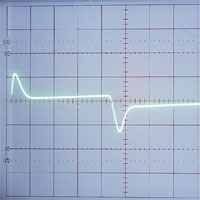Supra EFF-I Interconnects and Ply 3.4/S Speaker Cables
| Supra EFF-I Interconnects and Ply 3.4/S Speaker Cables |
|
From Sweden |
|
Milan Cernohorsky |
|
7 May 2001 |
Product under review:
RCA Interconnect model EFF-I.
Price: approx. 5000,- CZK
(US: 180 USD, UK: 70-80 GBP) per 0.7 m
Speaker Cable model Ply 3.4. Price: approx. 20 USD per meter
Jenving Technology AB
Backamo Grinneröd 12800
S-459 91 Ljungskile, Sweden
Tel: +46 (0)522-234 60
Fax: +46 (0)522-231 31
Web: http://www.jenving.se/
Email: jenny.jenving@jenving.se
Among the companies we contacted before our last year’s cable fest, there was one we were not all that familiar with: Supra from Jenving Technology AB, its headquarters and manufacturing facilities located in Ljungskile, Sweden. The company has been around for quite a while and is in fact one of the biggest and oldest specializing in the design and production of connecting components. Its Supra Classic 2.5 special cable, launched as early as 1976, was the first designed exclusively for speaker connection. There had been virtually no specialized production of this kind up to that point. The Classic 2.5 speaker cable has been successfully marketed ever since. Swedish Supra in 1976 established a whole new manufacturing industry in the field of high fidelity. Because of Mr. Tom Jenving’s busy schedule – he’s the owner and president of the company – we had to wait to get our hands on the top-of-the-line EFF-I. Supra does not have a dealer in the Czech Republic but their products can be ordered via internet.
(*ISL means that the cable comes in a set with original Supra RCA connectors.)
 Supra EFF-I Interconnects
Supra EFF-I Interconnects

The EFF-I cable’s inner construction is rather complex. It makes use of several techniques to minimize skin effect (EFF = Equalized frequency Flow). The EFF-I consists of two hollow silver-coated copper wires. The wall of the wire is 0.20 mm thick. The inside is filled with PE. Both wires have individual, two-layer shields made of PE (the first layer) and aluminum foil (the second layer). Further, there is a grounding wire inserted under the outer protective coat. The cable is of course directional and this is clearly indicated by arrows on the outer coat. The tested sample was 0.7m long and equipped with black screw-on RCA connectors, the quality of which can easily compete with world’s top products.
Parameters
Cable type: twin tube core R (Ohm/km) 37
Wire type: fibers C (pF/m): 77
Wire material: OFC L (uH): N/A
Shield: Al foil
Connector: Supra RCA
Dielectric: PE
Directionality: yes
set length: 0.7 m
Sound
Pretending not to be aware of them, I allowed the cables to burn in for two days before doing any critical listening. When I started the listening test I soon recognized a sound picture very similar to that of the well known KrautWire Model 4: flawless reproduction of the mid-range, space, and upper frequencies. When listening to Patricia Barber’s album Café Blue, a sharpness in her voice did not particularly please me. Nevertheless, I must say that it never reached the point of annoying sibilants. The reproduction of the very low end of the sound spectrum was quick and free of emphasis. I would not mind some deeper bass, but then, this negligible handicap must be partially attributed to the combination with the JPS UltraConductor speaker cables. (They work very nicely when combined with Maple Audio Ambiance or Proteus cables made by Purist Audio Design.) When I combined Supra with Supra afterwards, the sound and dynamics as well as space and all the details in the test recordings were dangerously close in quality to their expensive colleagues.
This cable, “loaded” in all respects, is currently available for about 180 USD. I think that the price is right. There are no dubious technological experiments applied in its construction. This sympathetic light-blue hose is a result of a genuine search for accurate and precise reproduction. Also, the 2000-2001 catalogue is simply perfect.
I strongly recommend the Supra EFF I cable to all of you who struggle with the control of the lowest frequency range, best achieved with at least partial removal of the speakers’ textile covers. You might then be able to hear more clearly the chirping of sparrows or murmuring ofwaterfalls in selected audio lovers’ recordings. This cable, and I am being serious now again, is simply great.
Supra Ply 3.4 / S Speaker Cable
 Geometry of the Cable
Geometry of the Cable

Graphs
Comparison with a standard quality twin lead and with a non-shielded model Ply 3.4:


Construction
This cable, an improved version of Ply 3.4, consists of two isolated spliced wires each of which is made of 192 strands of OFC, which is not silver, but tin coated. Using tin instead of silver produced favorable results in skin effect minimization and in slowing down the oxidation process. Tin, of course, reacts and oxidizes with copper, but Supra research showed that this oxide creates a barrier less dangerous for the transmission of frequency ranges than the oxide of silver and copper. It was therefore not necessary to use expensive Teflon. Diameter of the main wires is 2 * 3.4mm and the outer profile is 7.5 * 7.5mm. Resistance is very low, just 5.1 Ohm/km; inductance is 0.20 m H/m. Model S has, furthermore, each of the main wires shielded by tin-coated copper which reduces the permeation of EMI and RIF to better than 95%, according to measurements. The outer covering is gray-blue PVC, providing overall good flexibility. The manufacturer advises connecting the shield to the amplifier’s ground.
Enough about technical specifications. On to the listening test. I just want mention how I adjusted the shield so that it would reach the grounding screw which on my amplifier is located some 15 cm from the cable clamps. I soldered on two pieces of isolated copper wire which I attached to the grounding screw. The cable the company sent for the test was long enough and came with two sets of Fork banana plugs and forks.
Sound
I’ve already mentioned my attitude toward burn-in in the test of the EFF-I interconnect cables. However, I was not absolutely sure about its positive effect until I tested Supra Ply 3.4 S. When I first connected the “fresh” cable to the system I was rather disappointed. I tortured it for four hours, but the sound, in comparison with the reference set of JPS UltraConductor cables from Joe Skubinski, was no equal at the lowest and highest frequencies. The lows were less full and less concrete, the highs were as if filtered by a light blanket. I stopped the test and allowed a week for the cable to get used to the system. This is burn-in period the manufacturer recommends. I was really anxious to find out what what changes might take place. I left the system running for the week I was away on holiday. Worried lest my apartment burned down, I left the key with my neighbor – just in case.
When I returned home, I was pleasantly surprised. The sound had improved substantially. I can hear your “yeah, right,” but, believe it or not, the week of burn-in had a profoundly positive effect. In general terms, my system provides an excellent mid-range, great space reconstruction and clear highs. It is not particularly strong when it comes to the lows. I am quite happy with it, even though I yearn for a more solid foundation. The matured cable helped it to improve even in this range. I felt very good about the sound, or more precisely, about its overall balance. The lows became firmer and deeper. I had not heard such lows from my speakers since I borrowed the class-A amplifier Z-8A from a Czech firm AU/RA some time ago. The reproduction of the all-important mid-range was absolutely perfect, without hissing or a trace of sharpness. I particularly appreciated these qualities when listening to the vocals of The Hilliard Ensemble on their Lassus release. The space presentation is just great, its depth, flawless.
Conclusion
I recommend this Supra Ply 3.4 / S speaker cable to anyone who wants to add a quality product to his quality component system. People seeking improvement in the low range and balance, abundant detail yet at the same time relaxed, should by all means try it out. It offers all you can get in its price range. After slow start it has worked, at least in my system, its way right to the top.
Recommended way of connecting the speaker cable

Music Used in Testing
-
Dave Grusin, The Gershwin Connection
-
Victor Bailey, Low Blow
-
R. Towner-Gary Peacock, A Closer View
-
Bob James, Playin’ Hooky
-
Mighty Sam McClain, Give Me Up To Love
-
Johnny Adams, One Step In The Blues
-
Scott Henderson’s Tribal Tech, Thick
-
Tuck Andress, Reckless Precision
-
Bach/Vivaldi/Marcello, Violin and Oboe Concertos
-
Patricia Barber, Modern Cool
-
The Hilliard Ensemble, Lassus
![]()
Don’t forget to bookmark us! (CTRL-SHFT-D)
Stereo Times Masthead
Publisher/Founder
Clement Perry
Editor
Dave Thomas
Senior Editors
Frank Alles, Mike Girardi, Russell Lichter, Terry London, Moreno Mitchell, Paul Szabady, Bill Wells, Mike Wright, and Stephen Yan,
Current Contributors
David Abramson, Tim Barrall, Dave Allison, Ron Cook, Lewis Dardick, John Hoffman, Dan Secula, Don Shaulis, Greg Simmons, Eric Teh, Greg Voth, Richard Willie, Ed Van Winkle, Rob Dockery, Richard Doran, and Daveed Turek
Site Management Clement Perry
Ad Designer: Martin Perry


 Specifications
Specifications


Be the first to comment on: Supra EFF-I Interconnects and Ply 3.4/S Speaker Cables